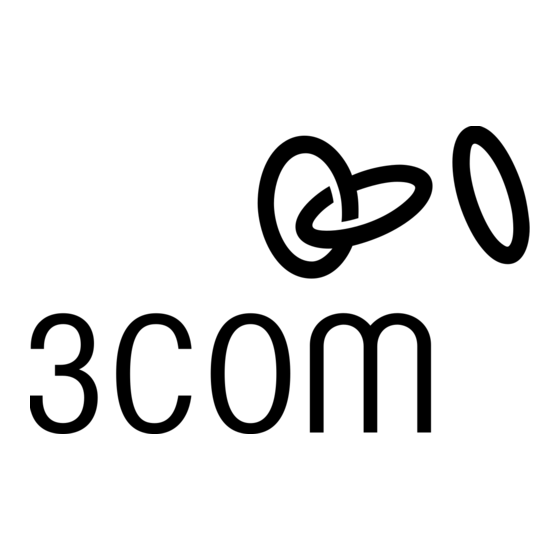3Com SuperStack 3 4900 Podręcznik użytkownika - Strona 5
Przeglądaj online lub pobierz pdf Podręcznik użytkownika dla Sprzęt sieciowy 3Com SuperStack 3 4900. 3Com SuperStack 3 4900 8 stron. 1000base-sx module (3c1771)
Również dla 3Com SuperStack 3 4900: Arkusz danych (2 strony), Arkusz danych (6 strony), Podręcznik użytkownika (8 strony)

P
ROBLEM
If you suspect a problem, carry out these steps before
contacting your supplier:
Ensure that the Module is correctly installed in the
Switch and that the three captive thumbscrews which
secure the Module are tightened with a suitable tool.
Ensure that the Switch in which the Module is fitted
is powered-up.
Ensure that the device at the far end of the link is
powered-up and operating correctly.
Ensure that all connectors on the fiber optic segment
are correctly engaged.
T
ECHNICAL
The SuperStack 3 Switch 4900 Series GBIC Module has
been designed to the following standards:
Functional
ISO 8802-3, IEEE 802.3-1998, IEEE 802.3ab, IEEE
802.1D, IEEE 802.1Q
Safety
UL 1950, EN 60950, CSA 22.2#950-93, IEC 60950, IEC
825-1, EN60825-1
EMC
CISPRR 22 Class A, EN55022 Class A, FCC Part 15
Subpart B Class A, ICES-003 Class A, VCCI Class A,
AS/NZS 3548 Class A, CNS 13438 Class A
Immunity
EN 55024
R
EGULATORY
FCC Statement
This equipment has been tested and found to comply with the limits for
a Class A digital device, pursuant to part 15 of the FCC rules. These
limits are designed to provide reasonable protection against harmful
interference when the equipment is operated in a commercial
environment. This equipment generates, uses and can radiate radio
frequency energy and, if not installed and used in accordance with the
instructions, may cause harmful interference to radio communications.
Operation of this equipment in a residential area is likely to cause
harmful interference to radio communications, in which case the user will
be required to correct the interference at their own expense.
Information To The User
If this equipment does cause interference to radio or television reception,
which can be determined by turning the equipment off and on, the user
is encouraged to try to correct the interference by one or more of the
following measures:
— Reorient the receiving antenna.
— Relocate the equipment with respect to the receiver.
— Move the equipment away from the receiver.
— Plug the equipment into a different outlet so that equipment and
receiver are on different branch circuits.
If necessary, the user should consult the dealer or an experienced
radio/television technician for additional suggestions. The user may find
the following booklet prepared by the Federal Communications
Commission helpful:
How to Identify and Resolve Radio-TV Interference Problems
This booklet is available from the U.S. Government Printing Office,
Washington, DC 20402, Stock No. 004-000-00345-4.
S
OLVING
S
PECIFICATIONS
N
OTICES
Clean the terminators by wiping them gently with a
clean tissue or cotton bud moistened with a little
ethanol. Dirty fiber terminators on the fiber optic
segment impair the quality of the light transmitted
through the cable.
For more general problem solving information, refer to
the documentation supplied with your Switch.
For information about technical support, refer to
"Technical Support"
Environmental
Operating Temperature
Storage Temperature
Operating Humidity
Power Consumption
Standards
In order to meet FCC emissions limits, this equipment must be used only
with cables which comply with IEEE 802.3.
CSA Statement
This Class A digital apparatus meets all requirements of the Canadian
Interference-Causing Equipment Regulations.
Cet appareil numérique de la classe A respecte toutes les exigences du
Règlement sur le matériel brouilleur du Canada.
CE Statement (Europe)
This product complies with the European Low Voltage Directive
73/23/EEC and EMC Directive 89/336/EEC as amended by European
Directive 93/68/EEC.
You must only insert a 3Com approved GBIC transceiver into the
Module. These are listed in the "Approved GBIC Transceivers" section of
this User Guide.
VCCI Statement
BSMI Statement
5
on
page
6.
0–40°C (32–104°F)
-10 to +70°C (14–158°F)
10–95% (relative humidity, non-condensing)
35 W (watts) maximum
EN60068 to 3Com schedule (Package
testing: paras 2.1, 2.2, 2.30, and 2.32.
Operational testing: paras 2.1, 2.2, 2.30 and
2.13).
